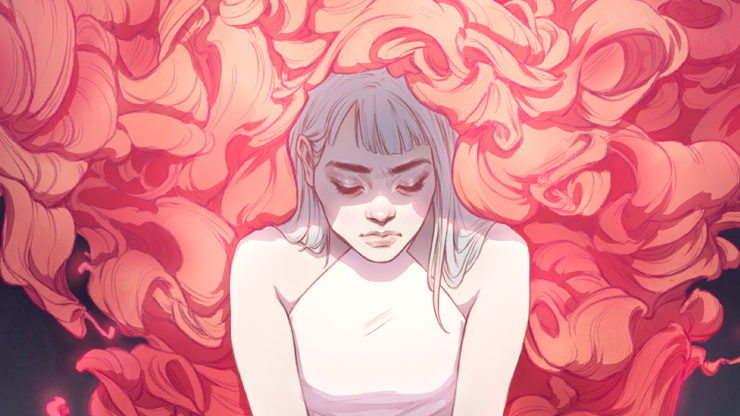Welcome back to Art of SFF—a column covering the best and brightest science fiction and fantasy artists. From newcomers to legends, Art of SFF pulls back the curtain to introduce you to the people behind your favourite book covers, films, and video games, and SFF-influenced art of all kinds. This time around, we chat with Djamila Knopf.
“The most amazing thing about art is that there are no limitations,” said the Leipzeig, Germany-based artist. “It allows us to travel through worlds that go far beyond our own. If I’m being honest, I see it mostly as a form of wish fulfilment. It gives me the chance to explore things that I otherwise couldn’t, and that’s especially true for science fiction and fantasy.”
Knopf cut her teeth on line-based and anime-inspired artwork, but after she decided to try her hand at professional illustration, she adopted a more “realistic and highly-rendered style” because she assumed that was the best (or only) way to make a living as a fantasy artist. “I worked hard and forced myself to paint realistically. I got good enough, but it never felt quite right.”
She continued along this path to the point of frustration, and started taking out her resentment on her work. It wasn’t really hers, she realized. “I asked myself what got me into art in the first place—what experiences I wanted to share.” So, she cracked open her old sketchbooks and dug childhood drawings out of the closet, determined to recapture a style that felt her own.
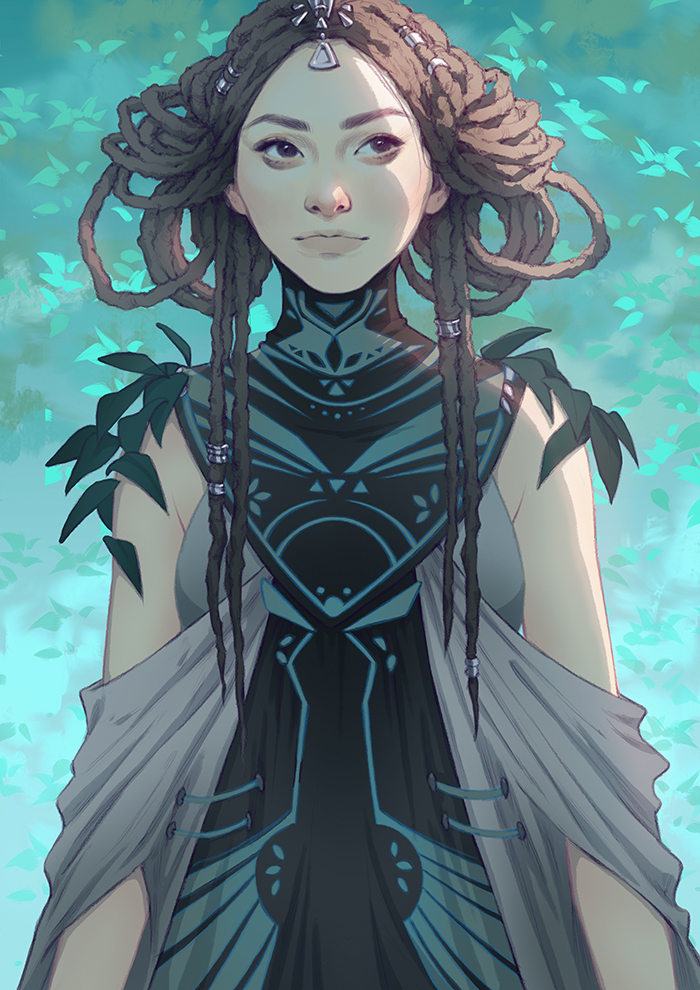
“I sketched and experimented. Over and over again,” she said. “After months of soul-searching, I arrived at my current style. I threw all expectations out the window of what fantasy art was ‘supposed to be like’ and focused on process. I’d always liked my preliminary sketches better than my finished art, so I kept the lines. I also switched a simpler, more efficient colouring style.
“Once I stopped trying to be something I wasn’t, it all just fell into place.”
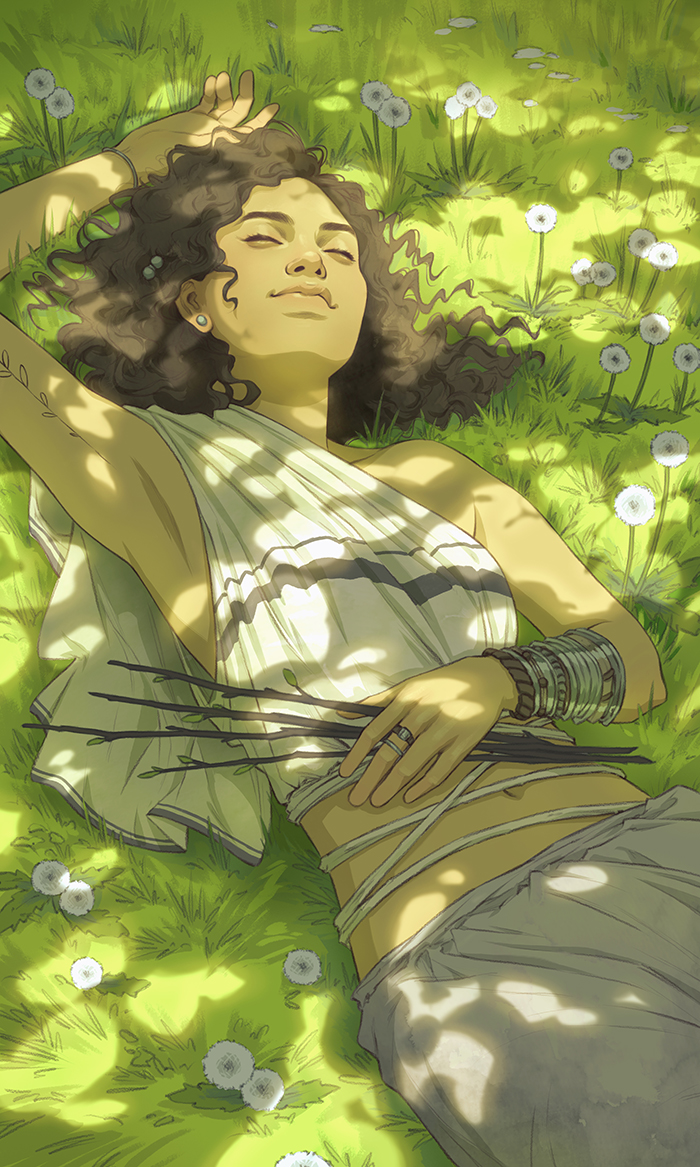
As a child, Knopf couldn’t be found without her coloured pencils and a piece of paper, always drawing. Like many young artists, a teenaged Knopf honed her craft by drawing and emulating her favourite characters and artists from Japanese anime. As she put her teens behind her, though, she discovered concept art and fantasy illustration and “started seeing art as a real career path” rather than a hobby. She spent her early twenties developing her style and process until she felt like they were at a professional level. During those six years, she studied at university, first enrolling in Japanese Studies, an offshoot of her love for anime. “I lived off of student loans and part-time jobs,” she said.
In 2017, she completed a Master of Education program, and found herself at a crossroads. Being a full-time artist was always the goal for Knopf, but she also knew that she needed another career path. Just in case. “While it was hard to juggle university, art, and part-time jobs,” states her website, “I’m glad I pushed through and got my degree, in case I ever want to pursue teaching or any other career path.”
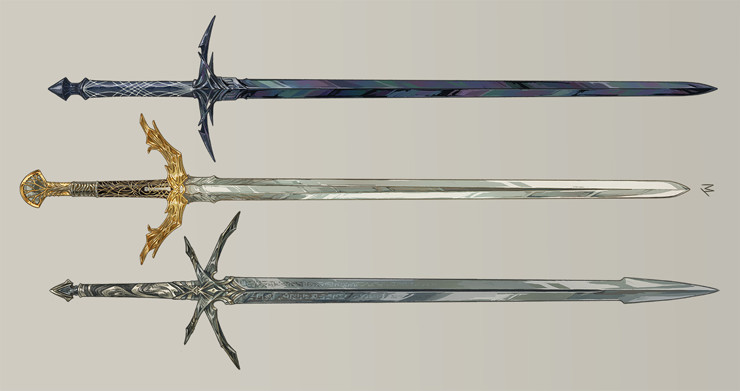
With university behind her, she started sending her portfolio to gaming companies and picked up work doing character illustrations, trading cards, and book covers. “After doing that for about a year, I started transitioning into doing more personal work. Now I almost exclusively live off of my Patreon as well as selling original art and prints. I still occasionally take freelance jobs—but only if they excite me, and feel like a good fit.”
Knopf has been making waves recently for one such freelance job. When Tad Williams announced an Indiegogo campaign for merchandise based on his Otherland and Memory, Sorrow, and Thorn series, the first time such merchandise was available, Knopf’s art was front and center. For the campaign, she created portraits of four prominent characters from the series—Simon, Miriamele, Binabik, and Aditu—along with the titular swords from Williams’ classic fantasy trilogy. And they are gorgeous.
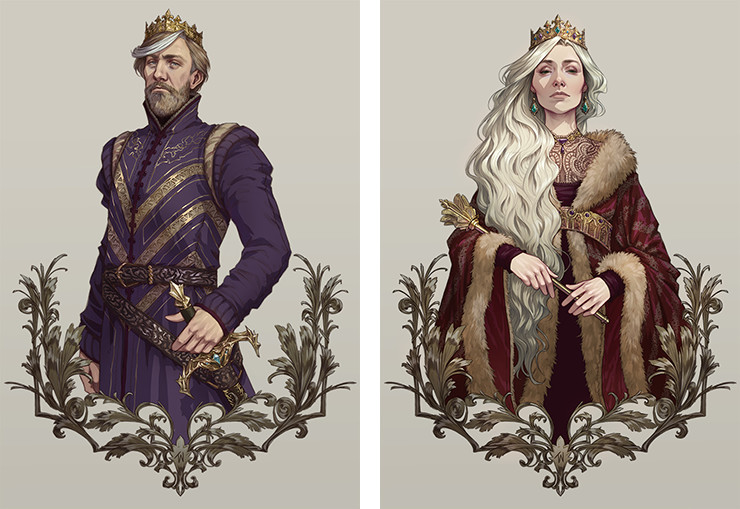
“I’d only read Tad Williams’ Otherland series [before taking the job],” Knopf admitted. She was even surprised to find out that he’d written a fantasy series. “His wife [and business partner] Deborah Beale was my art director, and made it very easy for me to get into the world [of Osten Ard] and connect with the characters. She provided me with detailed descriptions and reference images of models and clothing, kept me on track, and made sure that my illustrations conveyed the characters’ personalities. We had to start over on Miriamele, because my first sketch didn’t quite hit the right note, but it turned out to be the right decision in the end.”
As it happens, that hard work paid off. “She was my favourite portrait to illustrate. I love painting strong female characters. I had a lot of fun capturing her attitude and bringing her design to life—especially her hair.”
“Djamila is brilliant to work with,” Beale told me when I asked her about Knopf’s work on the merchandise. “She is amazingly generous with her knowledge.”
Beale and Williams first encountered Knopf’s work with a single “startling” portrait they stumbled across online. Beale went looking for the artist, and found Knopf on Deviantart. “I went into a sort of daydream about what she could bring to portraits of characters from The Witchwood Crown.” Beale knew that hiring Knopf meant elegant portraits, and that gave some shape to the merchandising campaign she had been working on for her husband’s books.
Djamila’s process begins with a pen, but not in the way you might think. “I like to start out writing rather than drawing,” she revealed. “I find it easier to come up with a solid concept if I can let my mind wander and get inspired by the words that pop into my head. That way, I can get away from the obvious first idea stumble.”
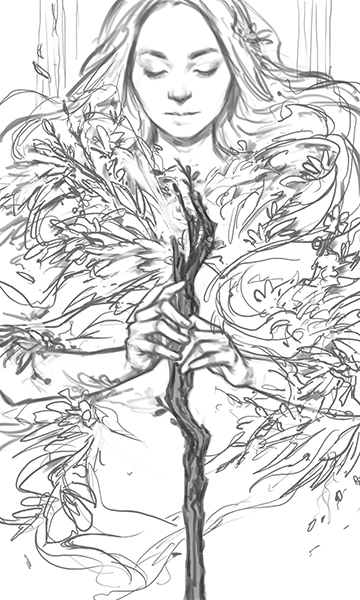
Once she has a concept, Knopf begins gathering reference images that will help bring her ideas to life. “I’m slightly obsessed with saving and categorizing inspiring images. I dig through all my folders that include colour palettes, faces, costumes, environments, etcetera, until I end up with 20 or 30 reference images.” She rarely needs them all, but their presence on her second computer monitor is a “safety net.” The variety, she says, keeps her from hewing too close to any single image.
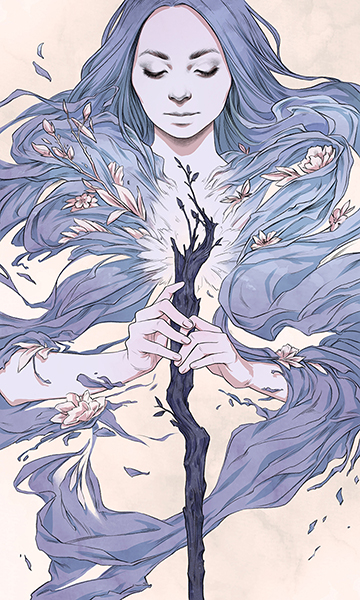
After a line sketch to nail down the concept, she does a pass to tidy up the composition, and then, finally, adds colour and shadows. “With this structured process, I rarely run into trouble, which is especially useful when I’m on a tight schedule. I know that some artists are more spontaneous than this, and I’ve felt embarrassed about it for a long time. But I do enjoy my process and it gives me the results I want, so I decided to just embrace it.”
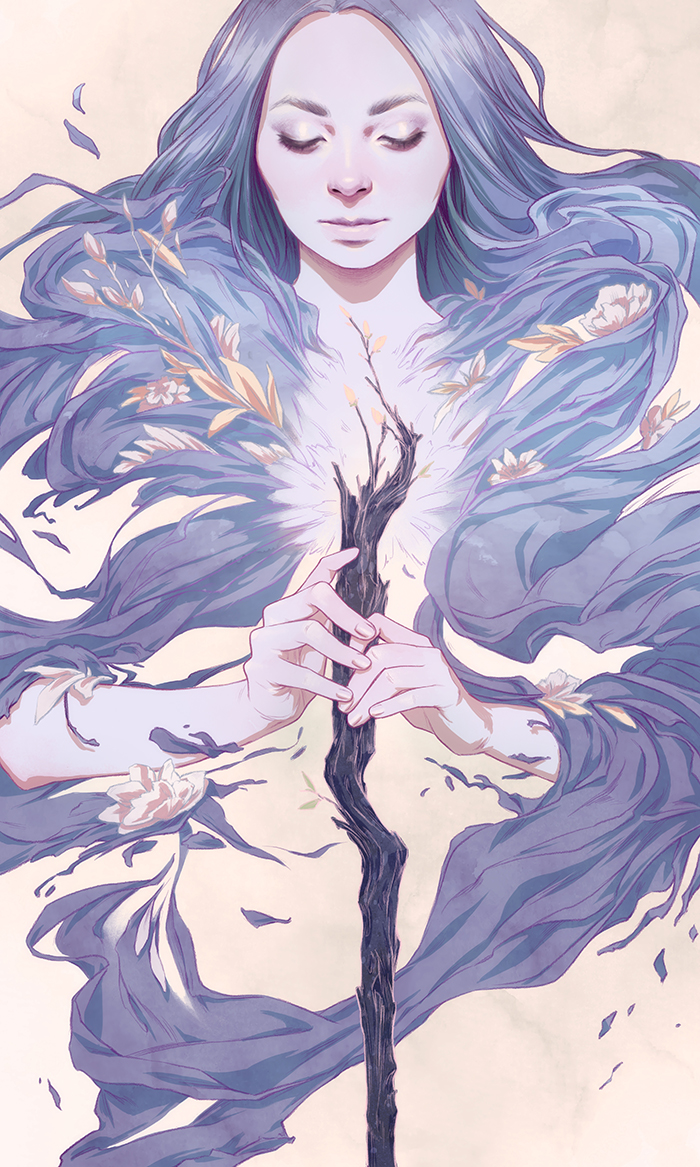
After abandoning her early attempts at a more commercial style, Knopf admitted that she struggled with understanding the best way to juggle her personal style with the needs of her clients. “Now I have a pretty easy answer: I only work with clients who hire me because of my style, not despite it. If I can’t be myself, I won’t take a job.”
Working for a client does require a different approach, though. “I take a few more steps than in my personal art,” Knopf described. “First, I provide a couple of rough sketches. This helps me nail down the overall look for the illustration. That’s followed by detailed sketches, then colouring. Following each stage, the client can request revisions. My main concern is to give them something that they’re happy with and that represents the art brief I’ve been given. Often, there are little costuming details or a certain expression/attitude that I need to get just right. That can take a few rounds of revisions.”
When it comes to her personal work, she considers herself the client, and she’s a harsh critic. “If I don’t like a certain hair or dress colour, I have the freedom to change it on the fly. And I’m not afraid to scrap a half-finished concept.”
As a young professional artist, Knopf leverages social media in every way she can. She’s running a Kickstarter, has a huge following on Twitter (@djamilaknopf), uploads process videos to YouTube, and got her start on Deviantart. Self promotion and belief in your art is key to launching and maintaining a successful freelance career, Knopf said. She recently went viral with a tweet that addressed the shame that some artists (especially aspiring ones) have in showing off and promoting their work.
https://twitter.com/djamilaknopf/status/977511732083068928
“From a business perspective, it is so important to get your work seen by potential clients and fans,” Knopf said. “You need to make it possible for them to find you, if you want to make a living as an artist.
“But on a more personal level, I believe that an essential part of art-making is sharing. I love this quote by Amanda Palmer on her creative process: ‘Collecting the dots. Then connecting them. And then sharing the connections with those around you. This is how a creative human works. Collecting, connecting, sharing.’ I couldn’t agree more.”
Being a freelance artist can be a solitary profession, so connecting with her peers and fans on social media is also a salve for boredom and loneliness. “I sit on my desk for long stretches, so at the end of the day, I look forward to sharing my creations with others. If there’s the slightest chance that I can brighten someone’s day with my work, I’ll take it.”
What’s the key to good self promotion? “Be human and interact with people!” Knopf said. “As visual artists, we tend to focus 99% of our energy on the drawing/painting part. When we’re done, we just dump the result online.”
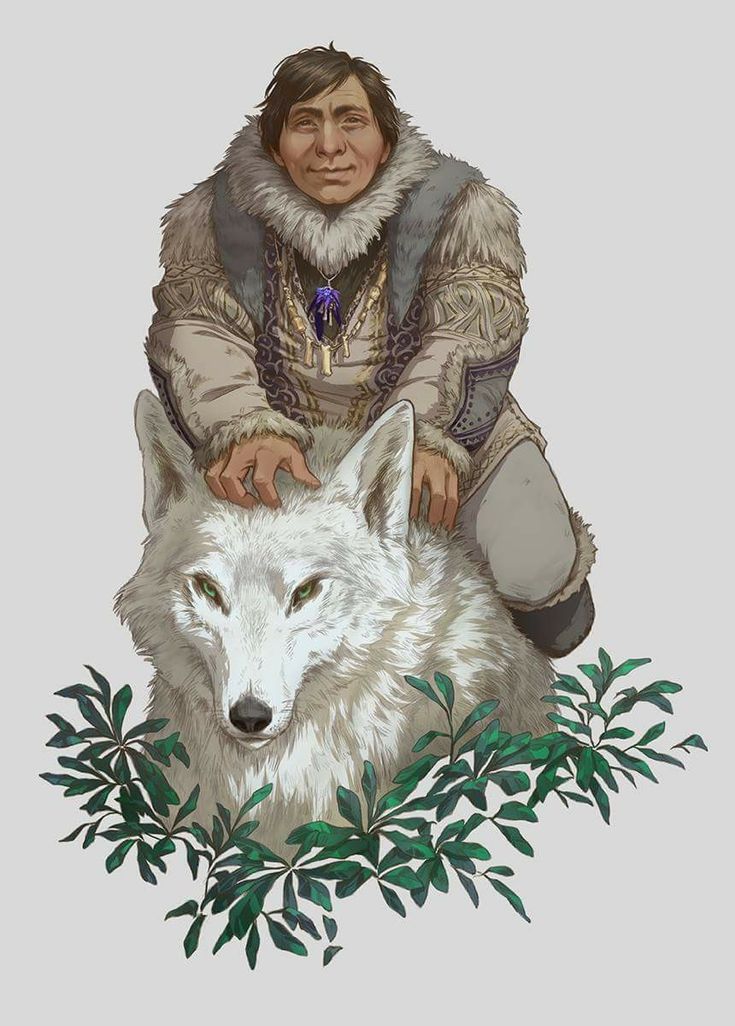
To address this, Knopf takes a proactive approach to promoting and sharing her art. “I try to put more love and compassion into it, just like a musician would at a live performance. Respond to people’s comments, write something about your process or why you’ve created a certain piece of art, discuss your struggles, elements of your craft that you want to improve, or things that interest and excite you. Be genuine and it’ll stop feeling like self-promotion and more like a conversation. And lastly, have faith that your audience will eventually find you, even if they aren’t there yet.”
“With huge TV shows and Hollywood movies, fantasy and science fiction are more popular than ever,” said Knopf. Though she admitted she’s no psychic, she’s excited for having a front-row seat as science fiction and fantasy fandom continues to develop, especially in the art world. “I love seeing fresh takes on imaginary worlds. I think it’s amazing that the genres are becoming more open and inclusive. As science fiction and fantasy have become such a big part of pop culture, their popularity also provides a platform for a lot of different voices to be heard.”
Aidan Moher is the Hugo Award-winning founder of A Dribble of Ink, author of “On the Phone with Goblins” and “The Penelope Qingdom”, and a regular contributor to Tor.com and the Barnes & Noble SF&F Blog. Aidan lives on Vancouver Island with his wife and daughter, but you can most easily find him on Twitter @adribbleofink and Patreon.










